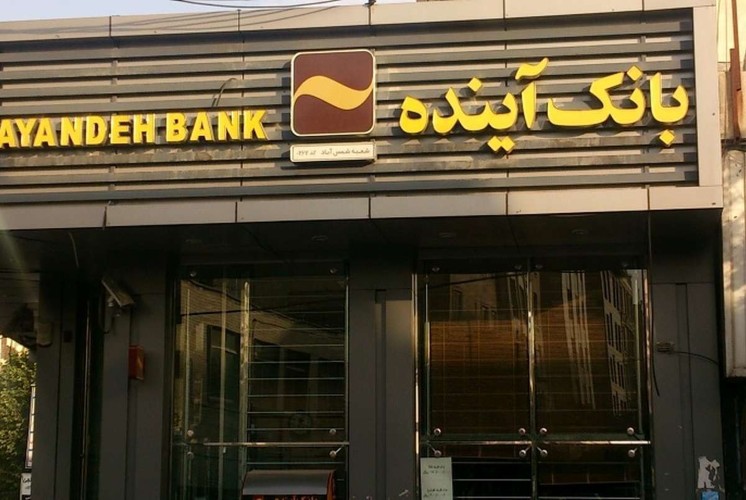With Bank Ayandeh dissolved and others facing insolvency, Iran’s fragile banking network teeters under mounting debt, hidden losses, and state secrecy
The official dissolution of Bank Ayandeh by Iran’s Central Bank marks one of the most serious financial failures in the regime’s recent history. As authorities begin transferring 2.5 quadrillion rials (250 trillion tomans) of deposits and liabilities from Ayandeh to Bank Melli, reports suggest that at least five other major banks—Sepah, Sarmayeh, Day, Iran Zamin, and Mellat—are also facing severe financial imbalance.
According to official data, Bank Ayandeh owed the Central Bank more than 5 quadrillion tomans, with its capital adequacy ratio plunging to an extraordinary –600 percent—a figure that indicates total insolvency.
Farshad Mohammadpour, the Central Bank’s deputy for supervision, justified the move by stating that the bank’s imbalance was “irreparable” and that Ayandeh had created a “false and dangerous image of the entire banking system.”
Under international Basel banking standards, a capital adequacy ratio of at least 8 percent is required for a bank to withstand financial shocks. Yet, Ayandeh’s ratio had dropped to nearly –350 percent, meaning the bank had no actual capital base and was effectively operating on borrowed deposits. All of its liabilities are now being transferred to Bank Melli, one of the country’s largest and most politically significant financial institutions.
But the crisis extends far beyond one failed bank. Central Bank figures show that out of Iran’s 29 licensed banks, at least 18 fall below the 8 percent capital adequacy threshold—placing them in a fragile or failing position. Eight banks, including Sepah (–23.2%), Iran Zamin (–21%), Day (–53.5%), Sarmayeh (–328%), and Ayandeh (–360.5%), report negative capital ratios, effectively rendering them bankrupt.
With over 42 million customers, the potential collapse of Sepah or another major lender could trigger a chain reaction across the entire financial sector. Low capital adequacy means these institutions lack the resources to meet depositor obligations, posing a severe risk to the savings of millions of Iranians—an issue the regime continues to obscure from the public through financial opacity and censorship.
In many countries, the failure of even a medium-sized bank can destabilize markets. In Iran, the simultaneous collapse of multiple large banks looms as a systemic risk. There is no credible deposit insurance mechanism and no sufficient reserve funds to protect ordinary depositors in the event of widespread insolvency.
This financial instability cannot be separated from the broader policies of the regime. Since the early 2010s, and particularly following the intensification of the regime’s nuclear and military programs, the economy has faced mounting international sanctions. The reactivation of the UN “snapback” sanctions in 2025 has tightened restrictions on foreign investment, currency access, and financial transactions.
These sanctions have frozen foreign assets and forced Iranian banks to rely on informal and costly exchange channels. In response, many institutions have resorted to borrowing directly from the Central Bank and expanding the money supply—fueling inflation, balance sheet distortion, and a rapid decline in public trust.
Only 10 Iranian banks currently maintain capital adequacy ratios above 8 percent, most of them small, specialized entities such as the Iran-Venezuela Joint Bank, Middle East Bank, and the Export Development Bank of Iran. These minor institutions play a marginal role in the broader economy. Meanwhile, the country’s large commercial and state-owned banks—from Melli and Sepah to Tejarat and Saderat—operate below or even far beneath global standards.
In essence, Iran’s core banking system is hollowed out. It survives only through heavy-handed Central Bank interventions, state directives, and the injection of public funds—all unsustainable in the long run.
The forced liquidation or merger of major banks in a country where over 80 percent of citizens hold deposits is not just a financial issue; it is a looming social and political crisis. The potential loss of savings and the collapse of trust in the financial system could trigger capital flight, currency shocks, and uncontrolled inflation.
The Central Bank face crippling sanctions, budget deficits, and limited capacity to rescue depositors through the Deposit Guarantee Fund. Experts warn that the country could see a repeat of the disastrous financial institution collapses of the 2010s—this time on a far larger scale.
While financial indicators point clearly to systemic insolvency, the regime continues to hide the crisis behind closed doors. Neither detailed financial statements nor transparent stress tests are made public. The sudden dissolution of Bank Ayandeh, rather than reassuring depositors, risks igniting a new wave of panic—exposing how deeply the foundations of Iran’s banking system have already crumbled.

